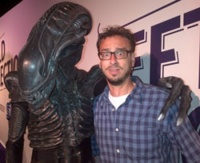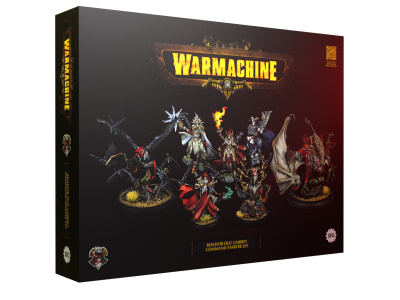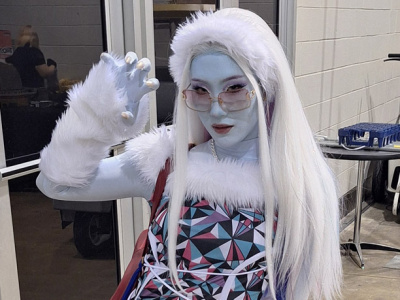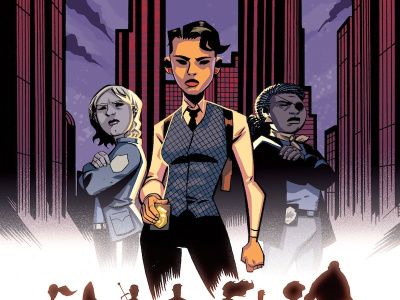 We caught up with ReedPOP Global SVP Lance Fensterman after C2E2 (see "C2E2 2014 Photos--Part 1"), to get his view on the show, and get more on the company's upcoming shows.
We caught up with ReedPOP Global SVP Lance Fensterman after C2E2 (see "C2E2 2014 Photos--Part 1"), to get his view on the show, and get more on the company's upcoming shows. You recently wrapped up C2E2. How did the numbers come out, and how do you think the show went overall?
Numbers came out good. It’s about 62,900. Solid growth (that’s 18.6% over last year, see "Fensterman Interview: C2E2 Tops 53,000"). The show floor grew by about 15,000 square feet of exhibitors, but the overall footprint grew even bigger because of the new hall that we’re in.
It felt busy. You’re always worried when you get into a bigger space that you want it to be jamming, but it felt busy. Our streaming numbers were up about 22% from last year, which was cool.
I think the content was good. We’re still trying to find the voice we want in our content and guests. It’s the fifth year, it’s crazy. I can’t believe we’ve been at it for five years, but we’re relatively pleased.
This was the first year without the Diamond Retailer Summit being held in conjunction with the show. How was the attendance on the trade and pro side? Was it more low-key because of the lack of the Diamond event?
The numbers of registered professionals was about the same, however the professional panels were light on Friday. DC came in and did their [version of a] retailer summit, so there was some attention being paid to the professionals. We will remain committed to doing programming and access for professionals. It’s in our core and what we built ReedPOP on. We’ll tweak and adjust it as we need to. If it needs to be a little lighter because of demand, we’ll do that.
There has been an explosion of regional shows over the past few years, but ReedPOP seems to be taking a fairly measured approach to new shows, either by acquisition or start-up. Can you describe your philosophy of growth in the US?
We made a decision early on to build large events, and fewer of them, than many smaller events. We felt it was better service to our exhibiting customers and the brands that we work with. It’s also how we’re geared as an organization; we work better in large scale. We felt that New York and Chicago were enough for us if we built them into large, large events; which we have in New York and are doing in Chicago. Then we turned our sights to international markets, the acquisition of Oz Comic-Con, which is five events in Australia (see "ReedPOP Ties Up with OZ Comic-Con"), and some other things we’re working on.
When you’re talking scale, we viewed large events in the US and then multiple events around the world as our scale play. I don’t know that there’s a wrong answer or a right answer. You see what other organizers have done running multiple events in more second tier markets and it’s proven very successful in their model.
Aside from the multiple event organizers, there are single show operations for events like Emerald City, Salt Lake City, Denver, but each seems to be growing and getting up to a level where Reed might be interested.
A lot of our resources are going to be going into international but we’re always looking for opportunities. Especially when you look at Emerald City, Megacon and Salt Lake, there’re just some fabulous events out there. They’re really strong.
A long-term trend that we’ve been noticing is the change in demographics of attendees at comic shows (see "Comic Conventions Are 'Like Going to the Mall'"). It seems that more casual consumers are coming out to look around and experiencing it as an event rather than the center of their existence like with traditional hardcore fans. Do you see that in your shows, or in your programming?
We don’t have demographic data back from Chicago, but in New York it’s typically 50%, sometimes more, are first-time attendees--so either the first con they’ve ever been to or the first New York Comic Con, they’ve ever been to. That’s been pretty steady for us.
The first year or two was more focused on hardcore fans, but it’s interesting. Depending on which exhibiting company you’re talking to, they either love it or they’re not sure what to do with it. You’re delivering new readers and new potential consumers. We think it’s cool that you’re getting that fresh perspective, not quite so jaded (been there, done that).
Is there any change over the years either in New York or Chicago in terms of gender, age or other key demographic variables?
It’s majority male across our events but each year the percent of females creeps up. We’ll see what it looks like in Chicago when we get that data back. Age remains pretty steady, 18 to 35. A little bit younger on our videogame shows, but that hasn’t changed dramatically.
What’s the gender mix change been like at C2E2?
Since 2011, the split between male and female has risen by 6% in favor of females.
You’ve got more U.S. shows coming up, including one in conjunction with BEA in a few weeks (see "ReedPOP Tries Book Fandom"). What are you doing to make books sexier or as exciting as the other kinds of pop culture shows?
Books are sexy, damn it! ReedPOP is based on finding passion in communities of fans and then delivering crazy, cool content to them. We’re trying to find that theme within books that contains that passionate fan--that love of content. We think we’ve got an interesting angle on this and we’re trying to build an event that caters to passionate consumers of books in all of their forms, and find that space where publishing books and pop culture collide.
You’ll see in some of the content, we’re pushing some film tie-ins, not solely, but some film tie-ins where Tina Fey and Jason Bateman with the author Jonathan Tropper who wrote the book the film (This Is Where I Leave You) is based on, with the film director, Shawn Levy. That’s one example of where it collides.
I think our content will reflect that collision of pop culture and books, and uncover the passionate fan base within the literary world.
In June you have Special Edition: NYC (see "ReedPOP Plans Comics-Only Show"). Why did you feel it is important to do a second show that’s more focused on comics in New York?
It’s two-fold. One, it’s what the market wanted. We felt the fan base in New York is big enough, passionate enough, and broad enough that they would support a second event. We’ve learned that the best recipe for success is to give the fans what they want.
Reason number two: as New York Comic Con gets bigger in every sense, bigger in its crowds and in its scope in content, we wanted to make sure we were always investing in and staying true the core of what we started, which is the comic artist and the comic fan.
How will it compare in size (percentage of the Javits Center) compared to New York Comic Con?
It’ll be intimate. We’re only going to use Javitz North, which is where Artist Alley was for New York Comic Con. That will be full of exhibits and artist tables and then a couple of panel rooms for some programming. Our aim was to keep it intimate and keep that connection between the readers and creators as strong and as close as possible.
Seems likely you’ll sell that out?
I hope so. We’ve got six weeks to go and we’ve got a lot of guests out there. It’s a pretty strong line-up. I’d stack it up against most line-ups. We’re just starting our marketing.
Are you making any changes to schedule or how you’re organizing things on a macro scale for New York Comic Con this year?
Not yet. We’ve got a couple of significant things in the works for New York Comic Con. Less within the building and more outside the building that we think will be pretty exciting. Hopefully by the end of May we’ll have some details to share on that. We’re thinking a little bigger around what we want to do with New York Comic Con.
Will it be the same schedule within the Javits: Thursday through Sunday?
For now we’re keeping it the same.
Anything else coming up for ReedPOP that we should know about?
Keep your eyes peeled. We’ve got some cool stuff both internationally and domestically that I think is going to be fun.







